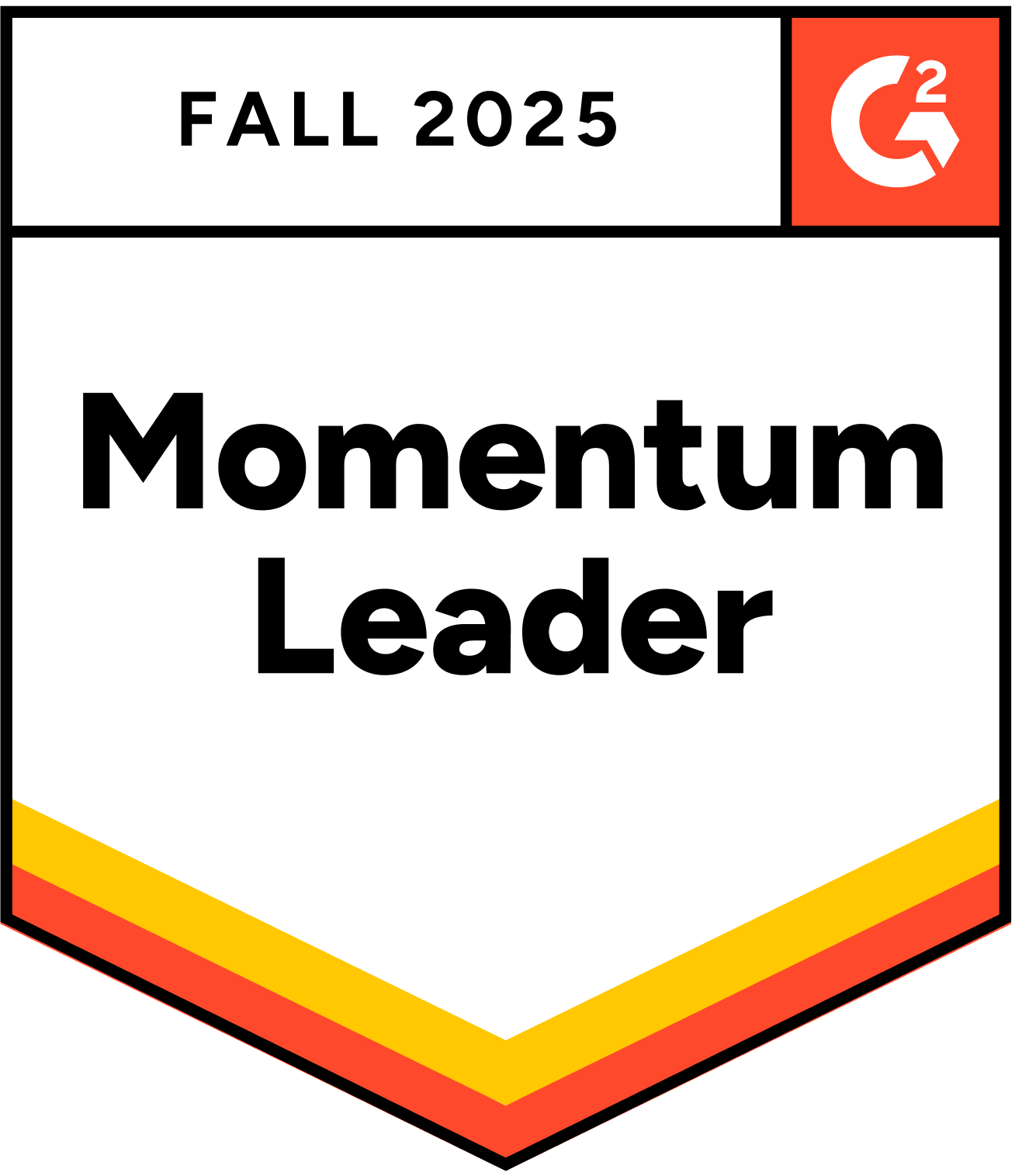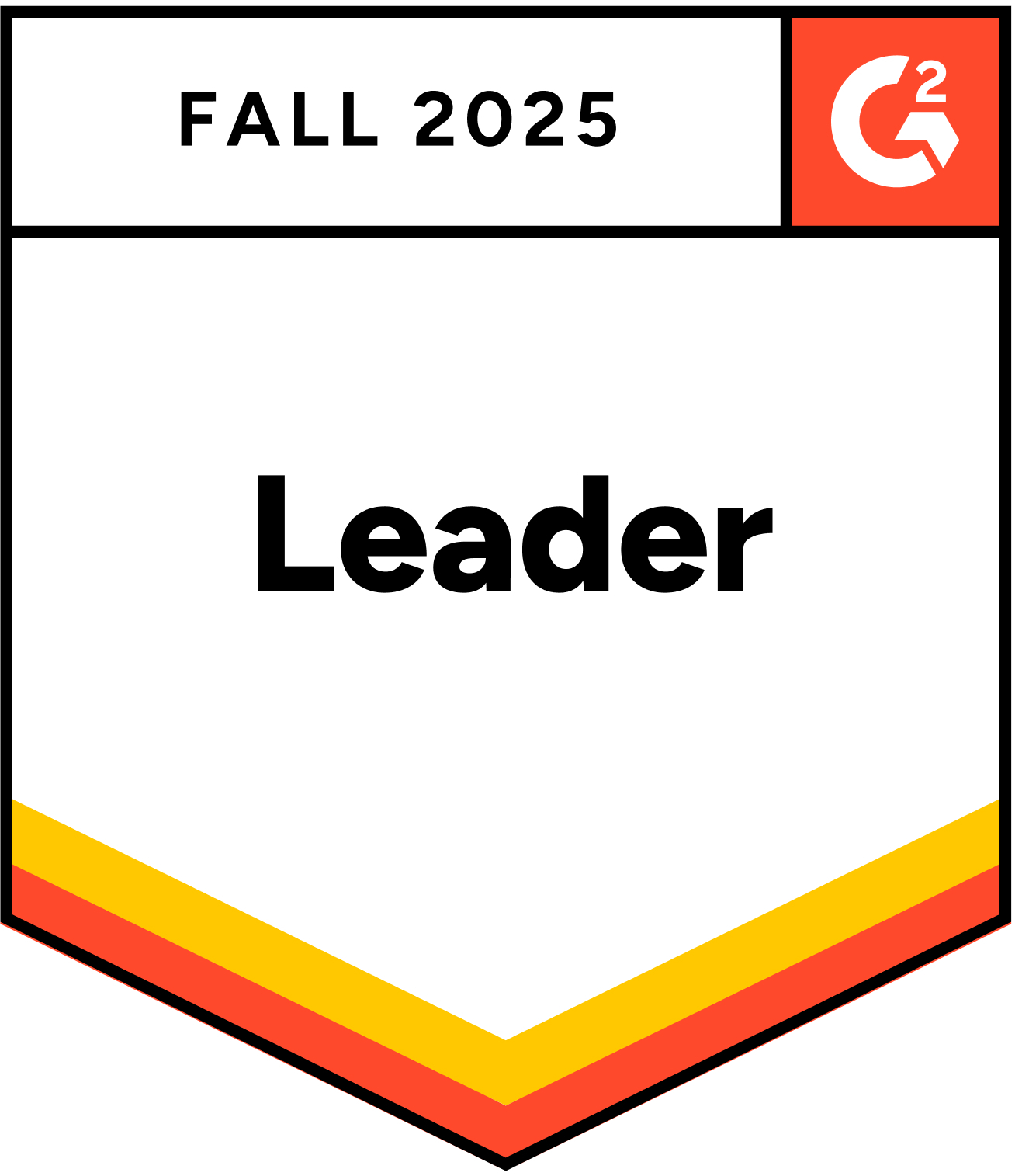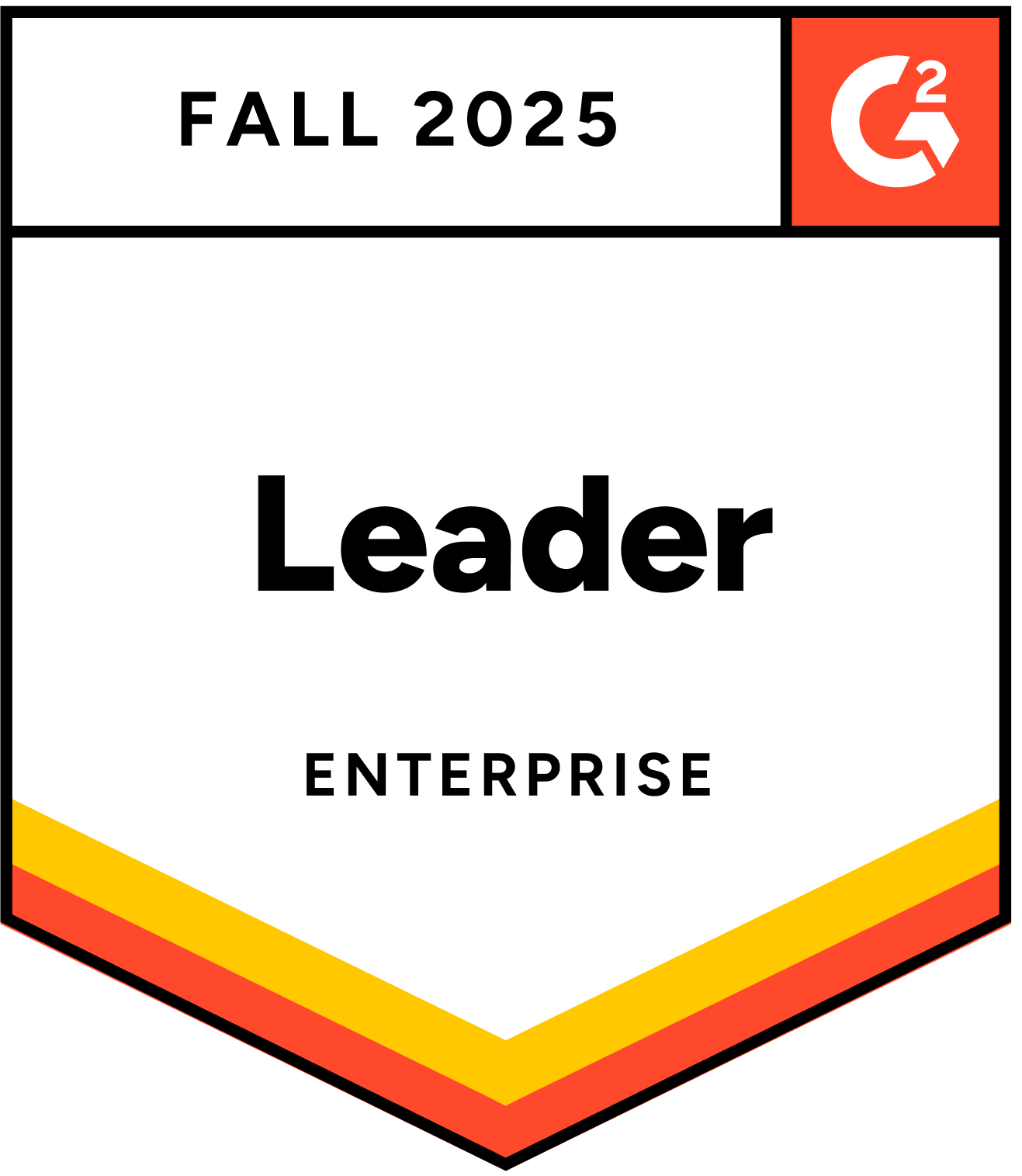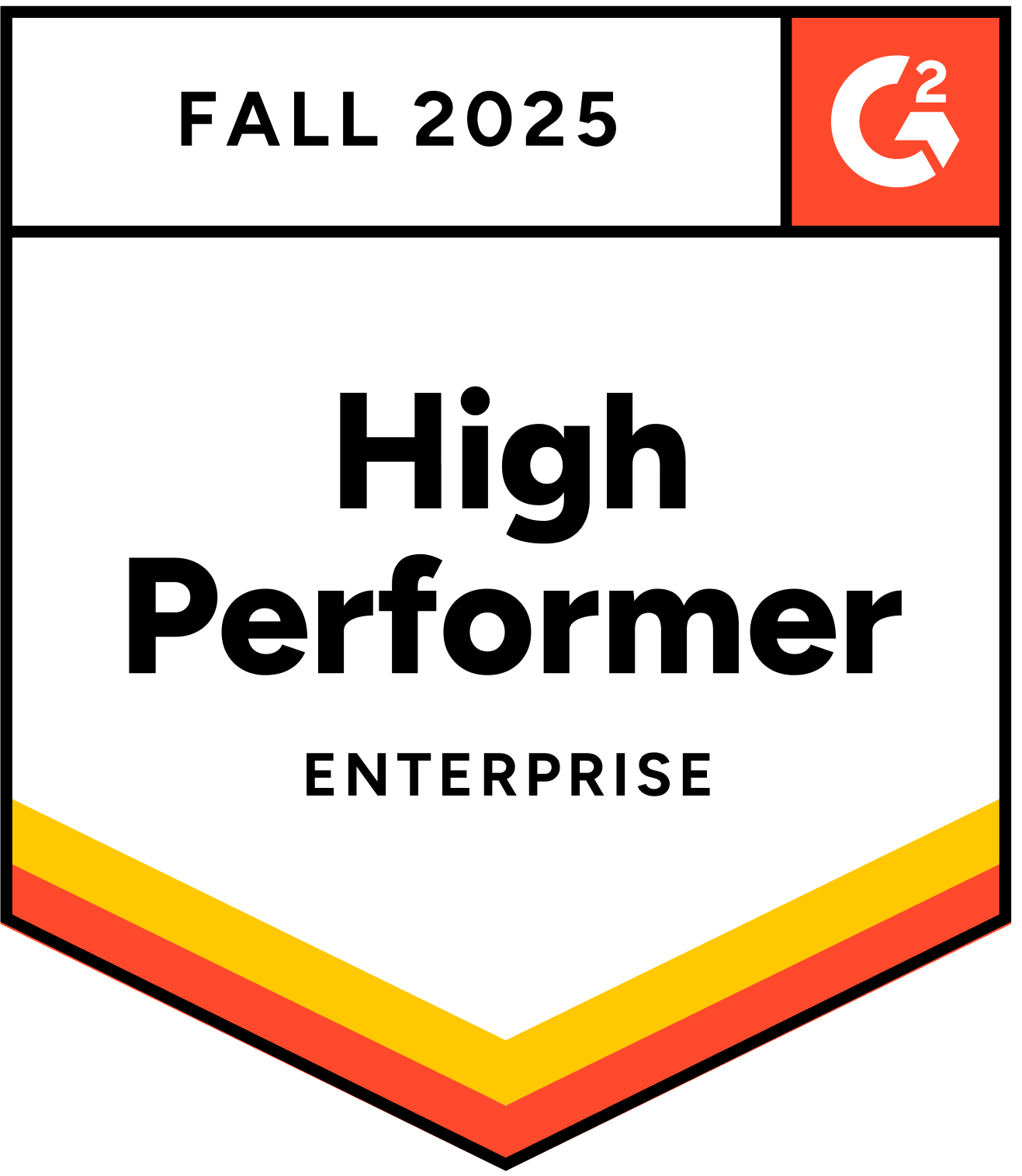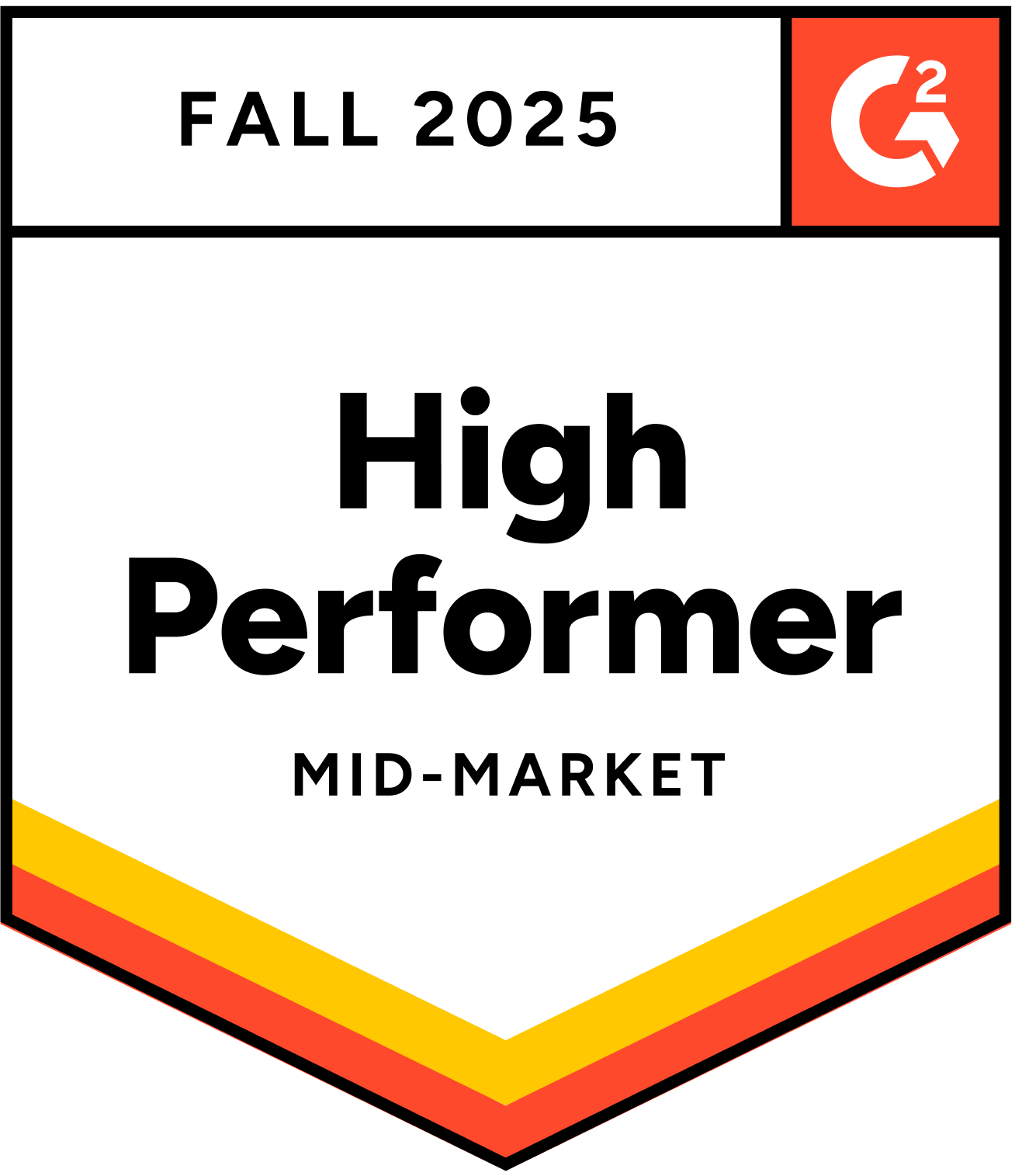Summary
A job description explains the main responsibilities, qualifications, and requirements of a role. A well-crafted job description attracts the right candidates, sets clear expectations, guides performance, and helps organizations hire efficiently by aligning the open role with business needs.
Introduction
Let’s be real – writing a job description (JD) that actually attracts the right candidate is not an easy task. Too much detail in there? You risk overwhelming potential candidates. Too vague? You’ll have to deal with loads of applications that are way off the mark.
But have no fear – we’ve got your back. As always!
Let’s dive deep into what makes a job description irresistible to top and great-fit candidates. Whether you’re recruiting for years or new to the space, you’ll find everything you need to create job descriptions that work hard for you. We’re talking optimized, engaging, and targeted JDs to bring in the best-fit folks for your vacant roles.
What Is a Job Description and Why Is It Important?

A JD outlines the key responsibilities, qualifications, and requirements for a specific role within an org. It’s a blueprint for employers and candidates, providing a clear understanding of what the job entails and what is expected from potential hires. A well-crafted job description should be thorough, clear, and concise, including the necessary elements – we’ll talk about these in detail a bit later.
What a job description should do
A job description is not just a list of demands – it’s your chance to showcase what makes your company a great place to work and what the role really looks like day-to-day. The primary objective is to help employers and candidates align their expectations. For employers, an effective job description:
- sets clear expectations regarding the responsibilities and duties associated with the position.
- helps draw in great-fit candidates with the right qualifications and experience.
- acts as a reference point for managers and HR to assess an employee’s performance against their responsibilities.
For candidates, a job description:
- provides insight into the company’s expectations and helps determine if the job matches their career aspirations and skills.
- suggests how to prepare for an interview.
- enables salary comparison, if included.
Why are job descriptions important?
Job descriptions might seem like just another HR formality, but they’re actually a big deal and serve multiple functions. Here are a few more reasons why they matter!
Streamlines the hiring process: When your job description is spot-on, you’re more likely to get applications from qualified candidates – meaning, less time spent recruiting the right fit.
Keeps you aligned and clear: Beyond hiring, job descriptions can act as official references, clearly outlining duties and responsibilities. This helps avoid misunderstandings or confusion down the road about what tasks fall under each role.
Drives retention: When employees know what’s expected and how their role fits into the bigger picture, they’re more likely to stick around. Those JDs work overtime for retention!
A good job description is the golden ticket to finding the perfect candidate for any vacant role. But here’s the twist – creating the perfect JD is quite a task. It requires striking the right balance between detail and conciseness, ensuring legal compliance, and creating content that appeals to the right audience.
And that’s why it is important to optimize job descriptions before sharing them with the world!
When job descriptions are optimized, they’re more likely to achieve higher click-through rates, better search rankings, and reach a wider, more diverse audience.
Perfectly optimized JDs (we can strive for perfection!) allow recruiters to spend more time engaging with candidates and less time sifting through unsuitable applications. They also enable sourcers to target candidates more precisely, ensuring that those who apply are truly aligned with the role’s requirements. In short, having an optimized job description can be the difference between attracting top talent and missing out on the perfect hire.
Guess what? We’ve got the perfect tool to help you optimize your JDs – our Job Description Optimizer is the perfect AI-based tool you need to get those JDs rolling! Free. Ungated. Built just for you.
How Our Tool Optimizes a Job Description
Let’s take a look at some of the JD info areas that job seekers care most about the most.
1. Job titles
Creative titles like “Ninja” or “Rock Star” might sound fun, but here’s the catch — they don’t show up in job board searches. If your job title isn’t something candidates are actively searching for, you’re missing out on top talent.
Try to use simple, relevant titles that reflect the job’s actual role. Think “Python Developer” instead of “Software Wizard.” It’s specific, clear, and gets in front of the right candidates. Also, avoid making your job titles look spammy. Adding location or salary details, like “Technician – CT Technician | Boston, Massachusetts | $2,528.76 Weekly,” can hurt more than help. Keep it straightforward and searchable, and watch your job ads get the visibility they deserve.
2. Format and readability
When it comes to grabbing attention, readability is key, and two things matter most: length and structure.
If your job description is too long, it’s likely to get skipped. Try using bullet points instead of long paras to break things up, making your content easy to skim through.
Now, let’s talk about tone. You’ve got three basic options:
Generic: Clear, straightforward, no fluff.
Formal: Filled with jargon and business buzzwords.
Casual: Conversational and maybe even a touch of humor.
Out of these, the generic approach gets more attention than others. Keep it simple, keep it clear, and your candidates will thank you!
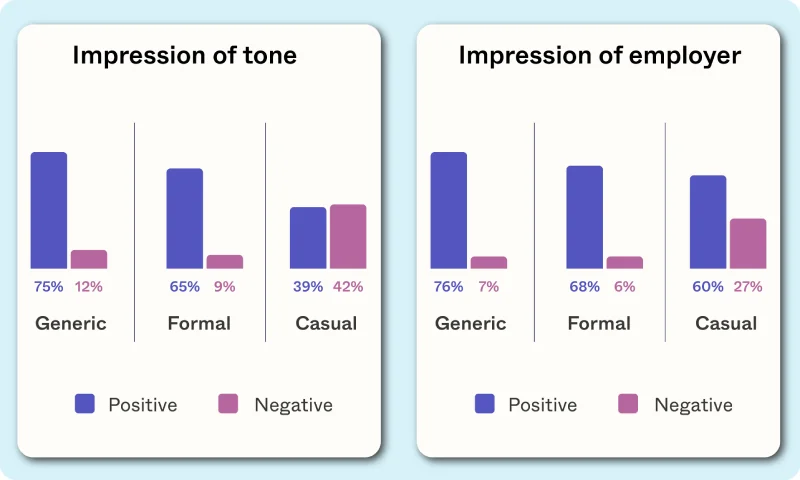
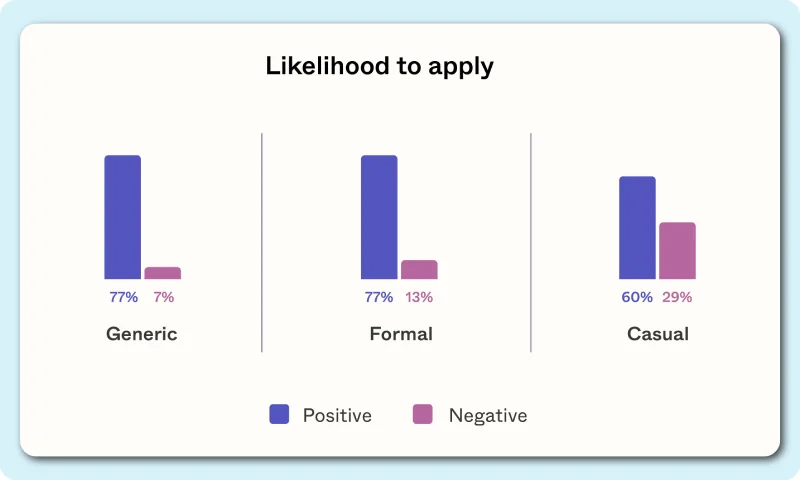
3. Responsibilities and qualifications
This is the section that candidates really look forward to – it gives them a picture of what their day-to-day will look like and what they need to bring to the table. So, keep it specific and detailed, but don’t overdo it. Here are a few tips:
- Focus on key tasks and projects they’ll handle, but don’t list every little thing.
- Aim for 4-6 bullet points to consolidate responsibilities and qualifications.
- Skip the super obvious stuff, like “must meet deadlines” – they get it.
- Make sure to include at least three bullet points that cover experience, education, and essential skills. But remember: keep it concise – this isn’t a laundry list!
4. Salary and benefits
This is a top priority for candidates, and you can’t afford to miss it. Make sure your job description has a dedicated section that clearly outlines compensation and perks, because that’s what grabs attention.
- Salary: Instead of just giving out a fixed number, provide a range and time period. For example, “$20/hour” or “$30k/year” beats just saying “$30k”. If possible, go a step further and break down the full compensation package to give candidates the complete picture.
- Benefits: This is where you sell the role! Separate your perks into their own section so they pop. Include health insurance, retirement plans, or even fun stuff like gym memberships to make it stand out.
Now, let’s dive deeper into how our free Job Description Optimizer can boost your listings.
(Heads up, we’re about to get a little technical, but don’t stress! The actual work really happens in a user-friendly dashboard that does all the heavy lifting for you.)
Key Elements for Optimizing and Scoring Job Descriptions
Over time, a great deal of research has identified key elements that make job descriptions more appealing to candidates. We’ve also leveraged insights from our large language model (LLM) to refine and create an optimized list of these critical dimensions.
Based on the findings, here are the ten dimensions we decided to use to score and optimize a job description:
- Job title
- Job location
- Format and readability
- Qualification
- Role and responsibility
- Company information
- Salary
- Benefits
- Equal employment opportunity statement
- Work flexibility
Job description scoring
Let’s see how each part of the job description is scored, starting with identifying the sections in the sample JD below.
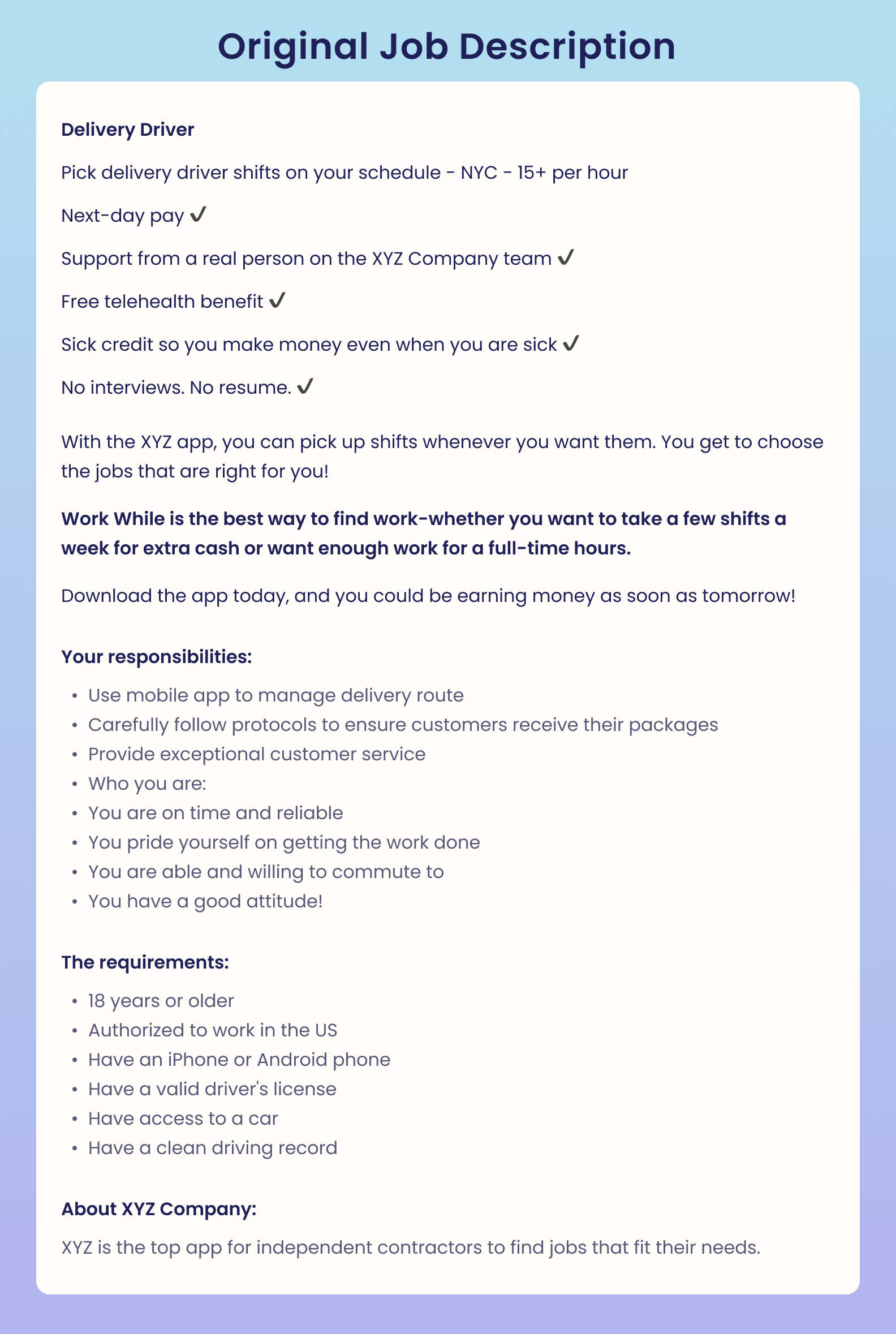
Section detection scoring
Our sample job description has the following sections, that have been scored 1 or 0, based on whether or not they were included.
- Job title: 1
- Location: 0
- Responsibilities/duties: 1
- Qualifications/requirements: 1
- Benefits: 0
- Salary/compensation: 0
- Equal employment opportunity statement: 0
The sample JD gets a 0.39 score. You must be calculating and wondering why the score isn’t 0.30. Well, that’s because some sections are more important and are weighted differently.
To improve this score and create a much better job description, we need to take a look at the sections which got a 0 score. A value of 0 could mean two things:
- The information is not present
- The information is present, but is unclear and/or complex
Once you’ve updated these sections, the score will improve. When everything is present and optimized, you’ll achieve a score of 1.
We know we got a bit technical there, but we wanted to explain our approach!
With our tool, you’ll see a much simpler version of this scoring process – each section of your job description will be rated as low, medium, or high to make it easy to understand, just like in the example below.
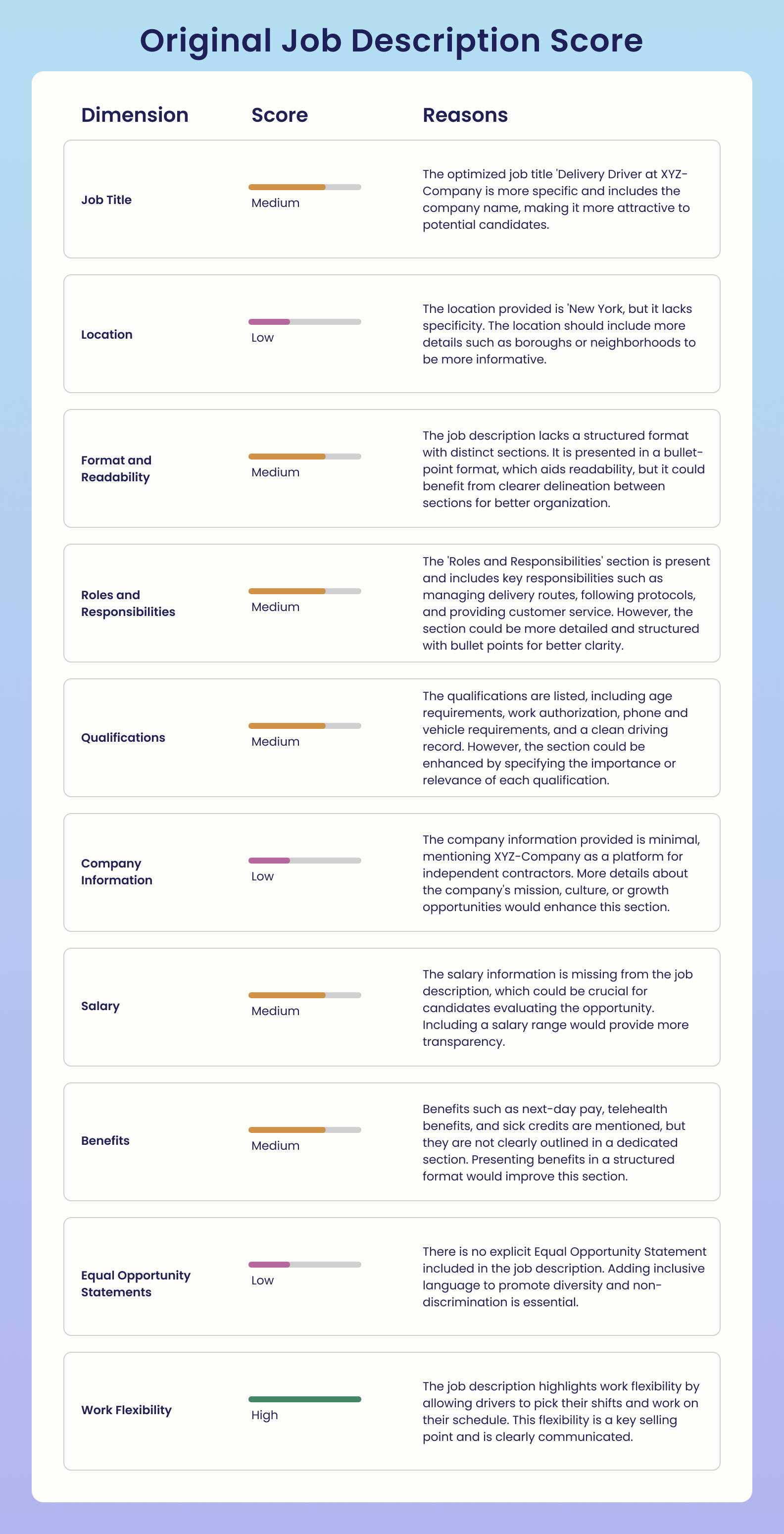
Job description optimization
After you’ve received your scores, our tool provides an optimized job description, along with the updated scores.
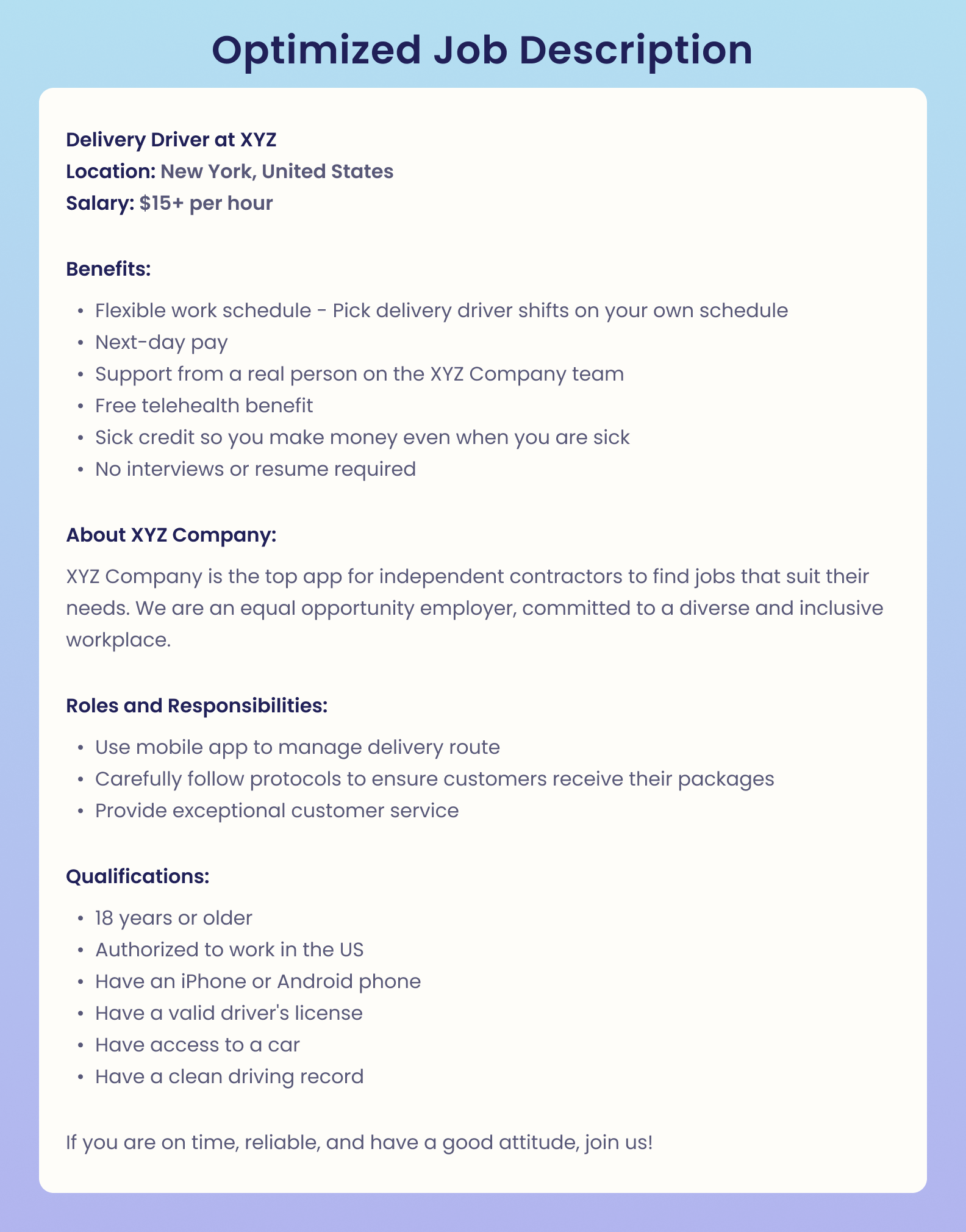
Following optimization, the final overall score stands at 0.89. Check out the dashboard feedback on our revised description.
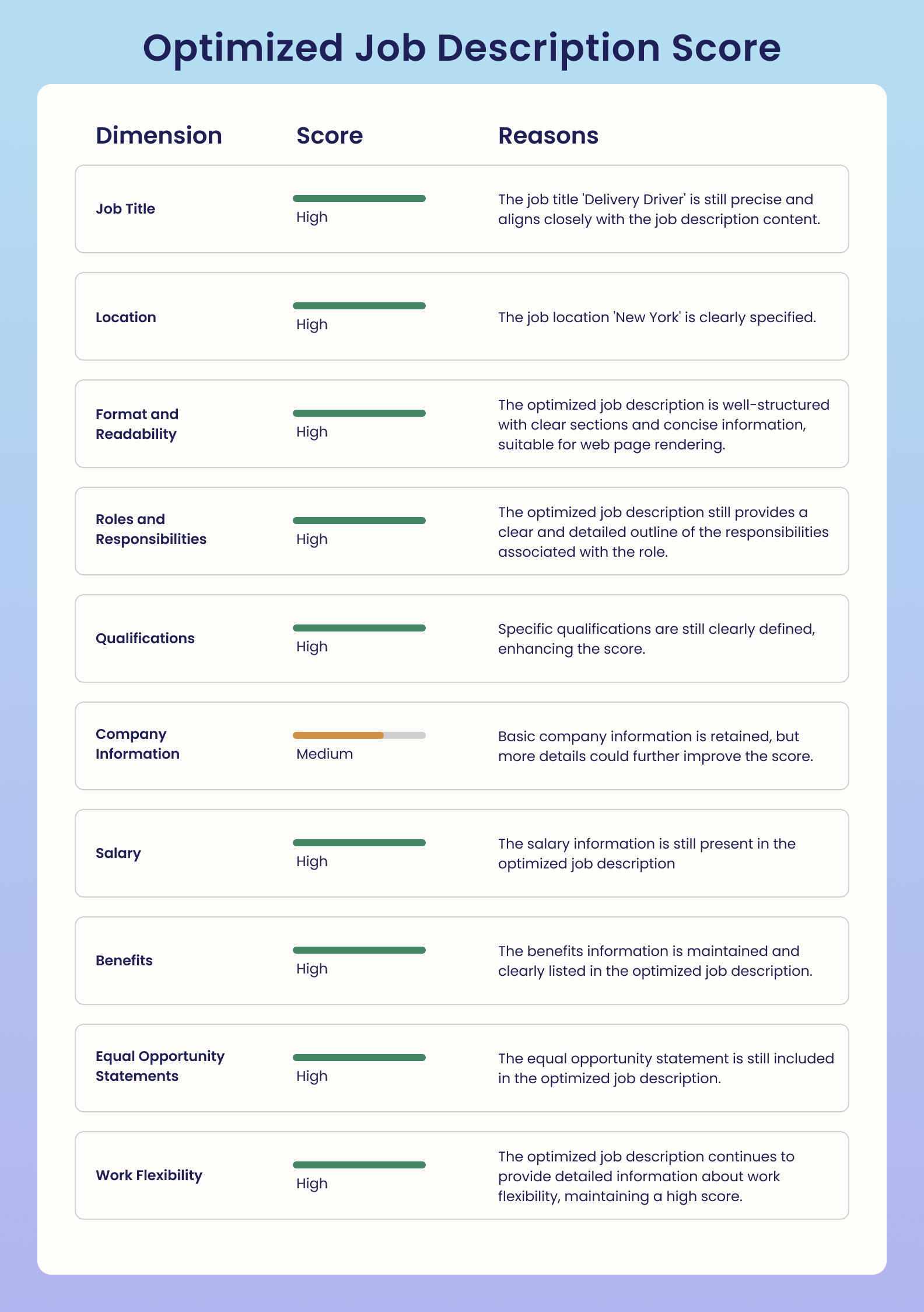
Tips to Write Effective Job Descriptions
With Joveo’s free Job Description Optimizer, you’ve already got a head start in having great job posts. But to take your descriptions from good to irresistible, we’ve gathered some expert tips to help you target the right candidates, in the right places, at the right time.
1.Know the role inside out
Before you even type a word in your job description, it’s important to understand what the role is all about. Here’s how your research should look:
- Consult hiring managers: Have detailed conversations to understand the role’s daily tasks, team dynamics, and department goals. Ask about the challenges the new hire will solve and the skills required to succeed.
- Talk to current role holders: Connect with people currently in the role. Ask them about their responsibilities, tools they use, and the essential soft skills needed.
- Check historical performance data: Review past performance indicators or employee reviews. This can clue you in on what has worked well and where past hires have struggled.
- Review industry standards: Look at similar roles on platforms like Glassdoor or LinkedIn to see what other companies are doing, from compensation to required skills.
2. Speak to your target audience
Tailor the language of your job description for the candidates you want. Here’s how:
- Build candidate personas: Develop profiles of your ideal candidates, including their career paths, communication styles, and motivations. Tools like LinkedIn Analytics or Google Analytics can help.
- Study competitor job posts: Check out how competitors are advertising similar roles and see what language, benefits, and/or structure they use.
- Learn from past posts: Dive into the metrics from previous job listings to see what attracted the most qualified candidates.
3. Shift focus on outcomes from just tasks
A list of tasks can come across as dull and boring. Instead, focus on outcomes:
- Highlight success stories: Showcase the achievements of people who have excelled in this role. What projects did they lead, and what impact did they have on the company?
- Align with business objectives: Connect the role’s responsibilities to the company’s larger goals.
- Gather customer or client feedback: If the role interacts with clients, feedback can help shape the outcomes you should spotlight in the description.
4. Be crystal clear about requirements
Specificity is key when listing qualifications and requirements. Research topics here should include:
- Conduct a skills gap analysis: Work with hiring managers to identify essential versus flexible skills, so you don’t scare off great-fit candidates.
- Know the certifications: Research industry-standard qualifications and training programs so you can list what really matters.
- Get applicant feedback: Check with past applicants about whether they felt any qualifications were unnecessary or absent. This insight can help you refine future posts.
5. Showcase your culture
Today’s candidates want to know what it’s really like to work for you. Highlight your company culture by:
- Using employee feedback: Tap into surveys or reviews on platforms like Glassdoor to understand what employees value most about your workplace.
- Promoting company events: Showcase initiatives, social events, or team-building activities that reflect your company’s vibe.
- Leadership tone: If your company culture is all about transparency or collaboration, reflect that in the job post’s tone.
6. Don’t forget to include a salary range
Transparency in compensation matters. Here’s how to get it right:
- Consult market salary data: Use tools like Unified Analytics or Payscale to establish a competitive salary range based on location and experience.
- Internal benchmarks: Ensure the offered salary aligns with what current employees are earning.
- Adjust for cost of living: If the role is remote or located in a different region, factor in local cost of living when setting the range.
7. Be inclusive
Make sure your job post welcomes diverse candidates:
- Use bias-checking tools: Joveo and other tools like Textio can help you identify and remove gendered or biased language.
- Diversity metrics: Look at your company’s current diversity stats to see where you can improve and tailor your language accordingly.
- Employee feedback: Gather input from employees of various backgrounds to ensure your job descriptions feel inclusive and appealing.
8. Strike a balance between concise and informative
Don’t overwhelm candidates with loads of info, but don’t leave them guessing either. Here’s how you can achieve the balance:
- Competitor analysis: See how long competitors’ job posts are and how they balance details with readability.
- A/B testing: Experiment with different lengths and formats to see what generates the best results.
- Readability tools: Use apps like Grammarly or Hemingway to ensure your posts are clear and concise.
9. Keep your job descriptions updated
Job descriptions shouldn’t be set in stone. Make it a habit to:
- Conduct annual audits: Regularly review job descriptions with hiring managers to keep them aligned with evolving role requirements.
- Collect post-hire feedback: Once the role is filled, ask the new hire how accurate the job description was, and make adjustments based on their feedback.
- Track industry trends: Stay current with trends that could impact role requirements or expectations.
Conclusion
A job description should not be thought of as a bunch of bullet points put together by someone in HR; it’s a powerful tool. In fact, it’s your first opportunity to connect with potential candidates, give them a glimpse into your company’s culture, and set clear expectations for the role.
By focusing on clarity, inclusivity, and relevance, you ensure that your job posting not only attracts candidates but also reflects your organization’s values. As you continue refining your approach to job descriptions, remember that the goal is to communicate your needs while resonating with candidates who share your vision.
Creating job descriptions that balance these elements may seem like a small task, but the impact on your recruitment success is undeniable.
FAQs
What is a job description?
A job description outlines the role’s responsibilities, required skills, reporting structure, and expectations. It helps candidates understand the job clearly and enables hiring teams to align on what success looks like, making it easier to attract the right talent and run consistent evaluations.
What is inside a job description?
A good job description typically includes the job title, summary, responsibilities, required qualifications, preferred skills, work environment details, and any compliance-related information. Together, these elements help candidates quickly understand whether they’re a strong fit and encourage more aligned applications.
How do I write a good job description?
Start with a clear, concise role summary, followed by responsibilities, skills, and expectations. Use inclusive language, keep it skimmable, and focus on impact rather than generic tasks.
What is legally required in a job description?
Legal requirements vary by region, but many organizations include essential job functions, physical or travel requirements, and equal opportunity statements. Some locations also mandate pay transparency. Clear, compliant job descriptions help protect employers while giving candidates accurate information upfront.
What is the most important section of the job description?
The role summary is often the most critical part because it shapes first impressions. It quickly tells candidates what the job is about, why it exists, and what success looks like. It helps them decide whether to read further and apply.
What is not included in a job description?
Job descriptions typically avoid personal characteristics, biased language, or non-job-related criteria. They shouldn’t include confidential information or vague expectations. Keeping the focus on essential functions and objective requirements ensures fairness and consistency in hiring.
How detailed should a job description be?
A job description should be detailed enough to clarify expectations but not overloaded with exhaustive task lists. The goal is clarity, not rigidity. Highlight major responsibilities and required skills while leaving room for growth, collaboration, and evolving business needs.


